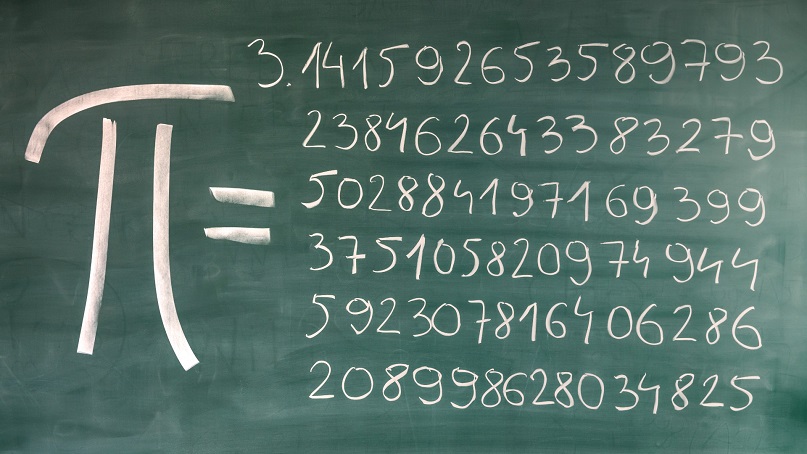
What Is Pi?
Pi represents the ratio of the circumference of a circle to its diameter.
By Marshall Brain & Dave Roos | How Stuff Works
Pi has mesmerized mathematicians for 4,000 years. It’s the rarest of mathematical constants, an unfailingly accurate ratio that’s also never-ending. The digits of pi have been calculated out to more than 22 trillion decimal places without ever repeating (that’s called an “irrational number”).
The definition of pi is simple: It’s a circle’s circumference divided by its diameter. (The diameter is twice the radius or double the length from any point on the circle to its centre. The circumference is the distance around a circle.) But what’s remarkable is that no matter the size of the circle you are measuring, that ratio of circumference to diameter will always equal 3.1415926535897, usually shortened to 3.14. Divide the circumference of a tennis ball by its diameter and you get 3.14. Divide the circumference of the planet Mars by its diameter and you get 3.14. Divide the circumference of the known universe by its diameter (assuming it’s a perfect circle or sphere) — you get the point. As one mathematician put it, “Pi is part of the nature of the circle. If the ratio was different, it wouldn’t be a circle.”
The following figure shows how the circumference of a circle with a diameter of 1.27 inches (32.35 millimetres) is equal to a linear distance of 4 inches (10.16 centimetres):

As you might imagine, 4.0 (the circumference) / 1.27 (the diameter) = 3.14.
Pi is critical to several basic calculations in geometry, physics and engineering, including the area of a circle (πr2) and the volume of a cylinder (πr2)h. When the ancient Babylonians attempted to measure the precise areas of circles back in 1900 B.C.E., they assigned a value to pi of 3.125. The ancient Egyptians came up with 3.1605. The Greek mathematician Archimedes (287-212 B.C.E.) and the Chinese mathematician Zu Chongzhi (429-501 C.E.) are co-credited with calculating the most accurate approximations of pi before calculus and super-computers gave us the definitive answer [source: Exploratorium].
In 1706, the self-taught British mathematician William Jones assigned the Greek letter π to this magical number without end, possibly because π is the first letter of the Greek words for periphery and perimeter. The symbol’s use was later popularized by 18th-century Swiss mathematician Leonhard Euler but wasn’t adopted worldwide until 1934.
The fact that pi can be found everywhere — not only in circles, but in arcs, pendulums and interplanetary navigation — and that it’s infinitely long has inspired a cult following that includes plenty of geeky tattoos and even its own national holiday. Keep reading to learn how you, too, can celebrate National Pi Day.
National Pi Day

National Pi Day was officially recognized by the United States Congress in 2009, but the (definitely not “square“) roots of the holiday can be traced back to 1988 and a man named Larry “The Prince of π” Shaw (source: Exploratorium)
Shaw was a beloved long-time employee at the Exploratorium, a science museum in San Francisco, California, and came up with the idea of “π Day” on a 1988 staff retreat following the death of Exploratorium founder Frank Oppenheimer. It was almost too perfect: The first digits of pi are 3.14 — March 14!
Even better, March 14 is also Albert Einstein‘s birthday, making π Day the ultimate geeky double-header.
The first π Day celebration was nothing more than Shaw and his wife handing out slices of fruit pie and tea at 1:59 PM (the three digits following 3.14), but the holiday quickly gained fame in the Bay Area.
Shaw eventually built the “Pi Shrine” at the Exploratorium, a circular classroom with a circular brass plaque at its centre. Every Pi Day celebration at the Exploratorium ended with a colourful parade led by Shaw blasting his boombox (with a remix of “Pomp and Circumstance” set to the digits of pi) and circling the Pi Shrine exactly 3.14 times. The parade ended with the singing of “Happy Birthday” to Albert Einstein.
The Prince of π passed away in 2017, but the annual Exploratorium party continues, as do π Day celebrations the world over. Popular ways to celebrate include baking a pie and other circular treats; making a construction paper pi chain, where each 10 digits are a different colour; and creating a collage out of circular shapes (source: National Pi Day).
You can also challenge your friends to a pi memorization contest, in case you’d like to get on the Pi World Ranking List. For a little context, the current world record for memorizing and reciting the most digits of pi was set by Suresh Kumar Sharma of India in 2015 when he recited a staggering 70,030 digits in 17 hours and 14 minutes. Why don’t you start with 20?
Frequently Answered Questions
What Are The First 200 Digits of Pi?
3.1415926535897932384626433832795028841971693993751058209749445923078164062862089986280348253421170679 821480865132823066470938446095505822317253594081284811174502841027019385211055596446229489549303819644 2881097566593344612847564823378678316527120190914564856692346034861045432664821339360726024914127372458 7006606315588174881520920962829254091715364367892590360011330530548820466521384146951941511609433057270 3657759591953092186117381932611793105118548074462379962749567351885752724891227938183011949129833673362 440656643086021394946395224737190702179860943702770539217176
What Is The First 100 Digits of Pi?
3.1415926535897932384626433832795028841971693993751058209749445923078164062862089986280348253421170679
What Number Is Pi Exactly?
3.141592653589793
Now That’s Interesting
The Pi symbol was introduced by William Jones, a Welsh mathematician, in 1706. In 1737, Leonhard Euler popularised the usage of the symbol. Pi Day was celebrated for the first time in 1988 by American physicist Larry Shaw. The value of Pi was determined till a record-breaking 22 trillion decimal places in 2017.
* * *
READ MORE: Japan Breaks World Record For Fastest Internet Speed
Read more on Amazing Physic News: Quantum Entanglement Wins 2022’s Nobel Prize In Physics
Liked it? Take a second to support Collective Spark.
We’d love to hear from you! If you have a comment about this article or if you have a tip for a future Collective Spark Story please let us know below in the comment section.
